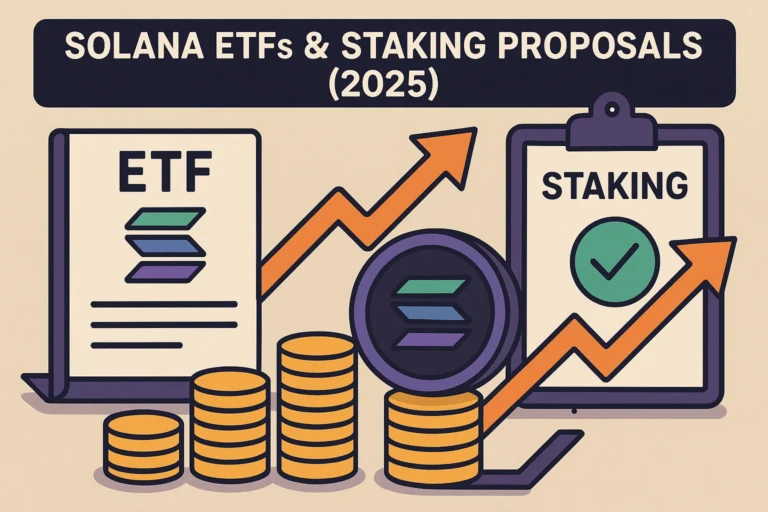The year 2025 marks a breakthrough for Solana ETF investments in the United States, with the first staking-enabled Solana ETF launching and multiple proposals pending SEC approval. The REX-Osprey Solana + Staking ETF (SSK) launched on July 2, 2025, as the first U.S.-listed ETF offering Solana exposure plus staking rewards, while prominent asset managers, including VanEck, BlackRock, and Franklin Templeton, await regulatory decisions on their spot Solana ETF applications.
Current Solana ETF Landscape {Current-Landscape}
The Solana ETF market in 2025 presents a mix of approved products and pending applications. Volatility Shares launched two crypto-linked Solana ETFs in March 2025: the Solana ETF (SOLZ) with almost $20 million in assets and the 2x Solana ETF (SOLT) with nearly $45 million. However, these are derivatives-based rather than spot ETFs.
The regulatory environment shifted significantly with the Trump administration’s crypto-friendly stance, leading to increased optimism for crypto ETF approvals. Bloomberg analysts Eric Balchunas and James Seyffart peg the odds of Solana ETF approval in 2025 at 90%.
Key Market Metrics
- SOL reached a peak market capitalisation of over $127 billion on January 18, 2025
- As of May 20, 2025, SOL’s market capitalisation was $87.6 billion
- Solana offers a 7.3% staking yield, attracting income-focused investors
REX-Osprey Staking ETF Breakthrough {Rex-Osprey-Breakthrough}
U.S.-made headlines by approving the first Solana staking ETF in July 2025, launched by REX Shares and Osprey Funds. This milestone represents the first time U.S. investors can access both Solana price exposure and staking rewards through a traditional brokerage account.
Fund Performance & Structure
The REX-Osprey SOL + Staking ETF (SSK) has shown impressive growth since launch:
- Surpassed $250 million in AUM as of September 11, 2025, just months after launching
- Structured under the Investment Company Act and holds Solana through a Cayman Islands subsidiary
- Aims to stake at least 50% of its holdings
Unique Features
The SSK ETF differentiates itself through several key features:
- Staking Integration: First U.S.-listed ETF to give investors exposure to Solana plus staking rewards in their securities brokerage accounts
- Accessibility: Allows traditional investors to access Solana ETFs & Staking without directly managing cryptocurrency wallets
- Income Generation: Combines Capital appreciation potential with passive staking income
Pending ETF Proposals & Timeline {Pending-Proposals}
Multiple prominent asset managers have filed Solana ETF applications with varying approval timelines:
Major Pending Applications
VanEck, 21Shares, Bitwise, Grayscale, Canary, and Franklin Templeton are among the asset management firms awaiting SEC approval on the Solana ETF. Each firm brings different approaches to Solana exposure and staking integration.
SEC Decision Timeline
The regulatory timeline has shown recent developments:
- The SEC is pushing issuers to amend and refile applications for spot Solana ETFs by the end of July
- The regulator delayed its decision on Franklin Templeton XRP and Solana funds by 60 days to November 14
- Solana ETFs could be approved in 3-5 weeks, with SEC signals of openness
Staking Integration & Rewards {Staking-Integration}

Staking represents a crucial differentiator for Solana ETFs, offering investors the potential for additional yield beyond price appreciation.
Staking Mechanics
Solana’s proof-of-stake consensus mechanism allows token holders to earn rewards by participating in network validation. The integration of staking into ETF structures provides several benefits:
- Passive Income: Investors earn approximately a 7.3% annual yield without active management
- Network Participation: ETF assets contribute to Solana network security
- Compound Growth: Staking rewards can be reinvested automatically
Regulatory Considerations
The SEC’s approach to staking in ETFs has evolved throughout 2025. The SEC delayed deciding on whether Grayscale could stake in its Ethereum exchange-traded fund, indicating careful consideration of staking mechanisms across different crypto ETFs.
Investment Comparison Table {Comparison-Table}
| ETF | Ticker | Launch Date | Type | Staking | AUM | Expense Ratio |
|---|---|---|---|---|---|---|
| REX-Osprey SOStakingking | SSK | July 2025 | Spot + Staking | Yes | $250M+ | TBD |
| Volatility Shares Solana | SOLZ | March 2025 | Derivatives | No | ~$20M | TBD |
| Volatility Shares 2x Solana | SOLT | March 2025 | Leveraged | No | ~$45M | TBD |
| VanEck Solana | Pending | TBD | Spot | TBD | – | – |
| Franklin Templeton Solana | Pending | Nov 2025+ | Spot | TBD | – | – |
Regulatory Developments {Regulatory-Developments}
The regulatory landscape for Solana ETFs has undergone significant changes in 2025, influenced by the new administration’s crypto-friendly policies.
SEC Policy Shifts
The Securities and Exchange Commission has shown increased openness to crypto ETF applications, particularly those involving staking mechanisms. This shift reflects broader regulatory acceptance of cryptocurrency as a legitimate asset class.
Approval Process Insights
The approval of the REX-Osprey staking ETF followed an unconventional path, structured under existing investment company regulations rather than as a traditional spot ETF. This approach may serve as a template for future staking-enabled crypto ETFs.
Market Impact Analysis {Market-Impact}
The introduction of Solana ETFs has created several market dynamics worth monitoring:
Price Stability & Liquidity
The crypto ETF enables traditional investors to purchase SOL through brokers, thereby increasing trading volumes and stabilising prices. This institutional access typically reduces volatility and improves market efficiency.
Institutional Adoption
ETF structures remove technical barriers for institutional investors, potentially driving significant Capital inflows to the Solana ecosystem. Traditional portfolio managers can now allocate to Solana without direct cryptocurrency custody requirements.
Ecosystem Development
Increased institutional participation through ETFs may accelerate Solana ecosystem development, funding projects and applications built on the blockchain.
Investment Strategies {Investment-Strategies}
Investors considering Solana ETF exposure should evaluate several strategic approaches:
Core-Satellite Approach
- Core Position: Allocate 2-5% of portfolio to established Solana ETF
- Satellite Positions: Consider smaller allocations to leveraged or specialised Solana products
Income-Focused Strategy
For yield-seeking investors, staking-enabled ETFs like SSK offer dual benefits:
- Capital appreciation potential from SOL price movements
- Steady income stream from staking rewards (approximately 7.3% annually)
Dollar-Cost Averaging
Given the volatility of cryptocurrencies, systematic investment approaches can help mitigate timing risks while building positions over time.
Risks & Considerations {Risks-Considerations}
Regulatory Risks
Despite recent approvals, the regulatory environment for crypto ETFs remains in flux. Policy changes could impact ETF operations or approval timelines for pending applications.
Technology Risks
Solana has experienced several high-profile outages in recent years, which could affect network reliability and investor confidence.
Market Volatility
Cryptocurrency markets remain highly volatile, with potential for significant short-term price fluctuations affecting ETF performance.
Staking Risks
Staking mechanisms introduce additional considerations:
- Slashing risks if validators misbehave
- Lock-up periods that may affect liquidity
- Technical complexity in staking implementation
Pros & Cons Analysis
Pros
- Easy access to Solana exposure through traditional brokers
- Potential for staking rewards, providing additional yield
- Professional management and regulatory oversight
- Diversification opportunity within crypto allocations
- No need for direct cryptocurrency custody
Cons
- Management fees reduce overall returns
- Less control compared to direct SOL ownership
- Regulatory uncertainty may affect future operations
- Limited track record for newer products
- Potential tracking errors versus direct SOL exposure
Action Plan for Investors {next-steps}
Step 1: Assess Risk Tolerance
Evaluate your comfort level with cryptocurrency volatility and determine an appropriate allocation size (typically 1-5% of total portfolio).
Step 2: Choose ETF Structure
Decide between:
- Staking-enabled ETFs for income generation (SSK)
- Simple spot exposure (pending approvals)
- Leveraged products for amplified returns (SOLT)
Step 3: Monitor Regulatory Developments
Stay informed about pending ETF approvals and regulatory changes that may affect your investment options.
Step 4: Implementation Strategy
Consider dollar-cost averaging for initial position building, then evaluate rebalancing frequency based on portfolio targets.
Step 5: Performance Monitoring
Track both price performance and staking yield generation, comparing against benchmarks and investment objectives.
Conclusion
The 2025 Solana ETF landscape marks a significant milestone in the accessibility of cryptocurrency investing. The successful launch of the REX-Osprey SOL + Staking ETF demonstrates regulatory acceptance of innovative crypto products, while pending applications from prominent asset managers suggest continued expansion of investment options.
US investors, Solana ETFs offer a regulated pathway to participate in one of blockchain’s fastest-growing ecosystems. The addition of staking rewards creates compelling value propositions that combine growth potential with income generation. However, investors must carefully weigh the benefits against the inherent risks of cryptocurrency and regulatory uncertainties.
As the market matures and additional ETFs receive approval, investors will gain more choice in how they access Solana exposure. The key is understanding each product’s unique features, risk profile, and alignment with investment objectives.
FAQs
Q: What makes the REX-Osprey Solana ETF different from other crypto ETFs?
A: It’s the first U.S. ETF to combine spot Solana exposure with staking rewards, allowing investors to earn approximately 7.3% annual yield in addition to potential price appreciation.
Q: When will prominent asset managers like VanEck and BlackRock get Solana ETF approval?
A: The SEC has set various timelines, with some decisions delayed to November 2025. Bloomberg analysts estimate a 90% probability of approvals during 2025.
Q: Are Solana ETF staking rewards taxable?
A: Yes, staking rewards are generally taxable as income when received. Consult a tax professional for specific guidance based on your situation.
Q: Can I lose money from staking in Solana ETFs?
A: While staking generally generates positive returns, there are risks, including slashing penalties and network issues, that could affect rewards. However, ETF structures typically manage these risks professionally.
Q: How do Solana ETF fees compare to direct SOL ownership?
A: ETFs charge management fees (typically 0.5-2% annually) that direct ownership avoids, but ETFs provide professional management, regulatory oversight, and easier tax reporting that may justify the costs for many investors.
See More: Altcoin Season 2025 Is Ethereum& Rise Signaling the Next Bull Run?


